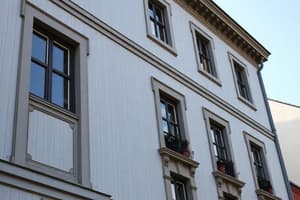Podcast
Questions and Answers
What should be ensured when cladding the corner bead of the ring groove?
What should be ensured when cladding the corner bead of the ring groove?
- Applying more current
- Increasing the travel speed
- Firm and accurate tungsten and wire setup (correct)
- Using a higher wire feed speed
What should be done after cladding the 1st bead corner?
What should be done after cladding the 1st bead corner?
- Start cladding on the rest seat pocket face with specified parameters (correct)
- Increase the wire feed speed
- Switch off the welding completely
- Reduce the current settings
What should be manually switched off during step up after stepping out from the corner pass?
What should be manually switched off during step up after stepping out from the corner pass?
- Tungsten heating
- AVC (Arc Voltage Control)
- Current settings
- Wire feed (correct)
What angle should be maintained to weld the ID of the seat pocket?
What angle should be maintained to weld the ID of the seat pocket?
What should be the gap between Tungsten and the part during ID cladding of the seat pocket?
What should be the gap between Tungsten and the part during ID cladding of the seat pocket?
What should be the inter-pass temperature range during cladding?
What should be the inter-pass temperature range during cladding?
When cladding the 1st layer taper area, how should the wire speed be adjusted?
When cladding the 1st layer taper area, how should the wire speed be adjusted?
What is the recommended starting and ending current to prevent undercut in the start-stop edges?
What is the recommended starting and ending current to prevent undercut in the start-stop edges?
What should be done prior to ID Cladding while cladding the Seat Pocket Face?
What should be done prior to ID Cladding while cladding the Seat Pocket Face?
What is the recommended tungsten to wire gap for vertical cladding (ID)?
What is the recommended tungsten to wire gap for vertical cladding (ID)?
Flashcards are hidden until you start studying
Study Notes
- Baker Hughes procedure for cladding a seat pocket map using a Confederate machine involves several steps and parameters.
- First, cladding the first bead corner and cladding the rest of the seat pocket face, using specific current, voltage, and wire feed.
- Ensuring the tungsten and wire setup is firm and accurate, and switching off the AVC for corner cladding only.
- After cladding the first bead corner, maintaining the horizontal axis dimensions from the remote control for each layer of seat pocket face cladding.
- Flush grinding the seat pocket excess cladding to the bore and surface cladding the Seat Pocket ID using given parameters and ensuring the tungsten and wire setup is firm and accurate.
- Maintaining torch angle, gap between tungsten and part, monitoring the weld, and adjusting the current accordingly during the cladding process.
- Other important procedures include ensuring interpass temperature, starting Seat Pocket ID cladding before ID cladding, controlling voltage, and maintaining the first layer of seat pocket straight.
- Procedures for cladding the Bonnet Cavity Bore, ensuring the corner bead of ring groove is cladded, and levelling and centering are also mentioned.
- The tungsten and wire setup and torch angle and wire setup are important for different features and positions.
- Ensuring the gap between tungsten and wire is 3.0mm for vertical cladding, the wire position for vertical and horizontal cladding is different, and the torch angle varies for different features and positions.
- Procedures also mention the importance of maintaining a firm and accurate tungsten and wire setup during the cladding process.
Studying That Suits You
Use AI to generate personalized quizzes and flashcards to suit your learning preferences.




